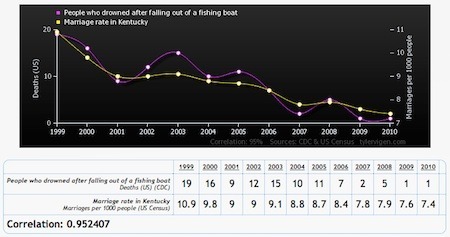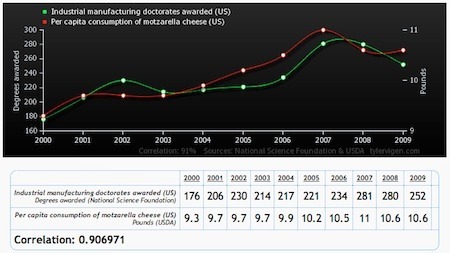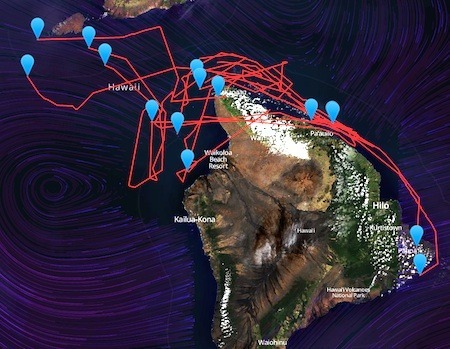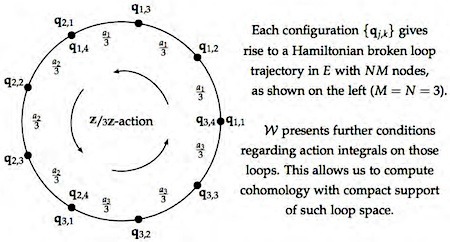Marc Abrahams's Blog, page 405
May 9, 2014
Spurious correlations, by the bucketful
 Tyler Vigen’s “Spurious Correlations” web site presents many spurious correlations.
Tyler Vigen’s “Spurious Correlations” web site presents many spurious correlations.
Correlation does not imply correlation, or so they say. What causes people to say that? You might ask that question of Tyler Vigen (pictured here), who is a student at Harvard Law School and a former store detective (at Macy’s) and also formerly a military geospacial intelligence analyst. Or you might ask Wikipedia. Or ask XKCD.
Here’s one of Tyler Vigen’s spurious correlations:
People who drowned after falling out of a fishing boat
correlates with
Marriage rate in Kentucky
Here’s another:
Industrial manufacturing doctorates awarded (US)
correlates with
Per capita consumption of motzarella cheese (US)

Profiling Professor Persinger – part 1
 Human brains and lightning-discharges – what might they have in common? Could there be potentially congruent scale-invariant quantitative properties connecting the two? These questions have been examined by professor Michael A. Persinger of the psychology dept. at Laurentian University, Ontario, Canada. The professor presents his findings in the May 2012 edition of the scholarly journal Frontiers in Integrative Neuroscience explaining that :
Human brains and lightning-discharges – what might they have in common? Could there be potentially congruent scale-invariant quantitative properties connecting the two? These questions have been examined by professor Michael A. Persinger of the psychology dept. at Laurentian University, Ontario, Canada. The professor presents his findings in the May 2012 edition of the scholarly journal Frontiers in Integrative Neuroscience explaining that :
“The space-time characteristics of the axonal action potential are remarkably similar to the scaled equivalents of lightning.”
As the professor points out, connections regarding animals and electricity were hinted at as long ago as the 18th century by investigators such as Luigi Galvani. But Persinger jumps several steps beyond Luigi and his galvanised frogs’ legs, by examining and comparing the transient energies of lightning bolts and the brain’s neuronal firings.
“The energy and current densities from these transients within their respective volumes or cross-sectional areas are the same order of magnitude. Length–velocity ratios and temporal durations are nearly identical. There are similar chemical consequences such as the production of nitric oxide. Careful, quantitative examination of the characteristics of lightning may reveal analogous features of the action potential that could lead to a more accurate understanding of these powerful correlates of neurocognitive processes.”
The paper may be read in full here: Brain electromagnetic activity and lightning: potentially congruent scale-invariant quantitative properties
Other Prof. Persinger publications include :
Persinger, M.A., & Makarec, K. Exotic beliefs may be substitutes for religious beliefs. Perceptual and Motor Skills, 1990, 71, 16-18.
Persinger, M.A., Balance, S., & Moland, M. Snow fall and heart attacks. Journal of Psychology, 1992, 127(2), 243-252.
Coming soon : Profiling Professor Persinger – part 2

The whales who traverse land
Today’s Cartography Puzzler: What is the story with the whales who apparently travel across large stretches of land?
Specifically, what is the story of the lines that cross land areas in this typical image, below, from the Smartmine Whale Tracker?
The whale tracker provides maps showing the location of many tagged whales. At the moment, those whales are all in or near the Hawaiian islands. Each blue upside-down-teardrop represents the current location of an individual whale. As you can see, a few of the red lines — which show the paths recently traveled by individual whales — cross directly over land areas.
Calibration, registration, and how many other -ions enter into the story of the paths that seem to show individual whales swimming, walking, flying or tunneling across, over, through, or under land areas?
The Huffington Post wrote a report about the whale tracker.
BONUS: See if you can determine whether the tracker is doing live tracking, or using a pre-loaded set of data. [HINT: Re-load the tracker page several times, and each time pay attention to the initial locations and movements of the whales.)
BONUS: For background on how the technology of maps, mapping and navigation evolved, take a wander across, over, or through Hiawatha Bray’s new book You Are Here: From the Compass to GPS, the History and Future of How We Find Ourselves.

May 8, 2014
Boxes for rocks — their own story
Boxes for rocks grow from much thought and careful effort, what with the desire that each box fit snugly and well in enclosing a particular rock. Ann Macmillan, say those who know, “creates cardboard boxes for rocks that are designed to fit each rock’s individual surface. After 3D scanning them and unfolding the rock’s geometry, the design is laser cut onto cardboard. She then carefully hand folds the cardboard around the rock, leaving gaps to show the process.” These boxes for rocks were what earned Ann Macmillan a Schnitzer Prize from MIT, the institution at which the boxes and the rocks are on display, presumably in a room inside a building.
BONUS (not necessarily related): “Rock Box”, performed by RUN-DMC, introduced by Professor Irwin Corey:
BONUS (not necessarily related): “My Pet Rock and Me: An Experimental Exploration of the Self Extension Concept,” Tina Kiesler and Sara Kiesler, Advances in Consumer Research, vol. 32, no. 1 (2005).
BONUS: Pet Rock boxes

Official Harvard interview with Steven Pinker and his hair
Steven Pinker, psychology professor extraordinaire and charter member of the Luxuriant Flowing Hair Club for Scientists (LFHCfS), gave an interview to Colleen Walsh of the Harvard Gazette. Here is the concluding section of the interview. The accompanying photo is by Stephanie Mitchell of the Harvard News Office:
Q: No Steven Pinker interview would be complete without a question about your hair. I recently saw a picture of you from the 1970s, and your style appears unchanged. Why haven’t you gone for a shorter look?
A: First, there’s immaturity. Any boy growing up in the ’60s fought a constant battle with his father about getting a haircut. Now no one can force me to get my hair cut, and I’m still reveling in the freedom. Also, I had a colleague at MIT, the computer scientist Pat Winston, who had a famous annual speech on how to lecture, and one of his tips was that every professor should have an affectation, something to amuse students with. Or journalists, comedians, and wise guys. I am the charter member of an organization called The Luxuriant Flowing Hair Club for Scientists. The MIT newspaper once ran a feature on all the famous big-haired people I had been compared to, including Simon Rattle, Robert Plant, Spinoza, and Bruno, the guy who played the piano on the TV show “Fame.” When I was on The Colbert Report, talking about fear and security, he pulled out an electromagnetic wand and scanned my hair for concealed weapons. So it does have its purposes.

Evolution of Complexes from LEGO™ Bricks in a Washing Machine
“Evolution of Complexes from LEGO™ Bricks in a Washing Machine“, by Ingo Althöfer, appears in the special Cloning & Evolution issue of the Annals of Improbable Research. (The article is also online.) It begins:
Disclaimers: This work has not been supported by the LEGO Group or any other brick toy company This work has not been sponsored by the Miele domestic appliance and machine manufacturing company. This work has not been supported by the artist Piet Mondrian.
Some people use their washing machine to clean LEGO bricks. No surprise, it works. But more than just cleaning occurs. Typically during the washing process, some of the bricks join together randomly, forming complexes. I observed the phenomenon (see Figure 1), and became curiously obsessed. I spent the next nineteen and a half weeks conducting many brick washing sessions.…

May 7, 2014
Saturday is Dr. Yoshiro Nakamatsu Day at the Comfort Inn
The Colorado Springs Independent reports:
He invented the floppy disk, digital displays and has more patents — upwards of 3,200 — to his name than Thomas Edison.
He photographed every meal he’s eaten since the 1970s, which won him a 2005 Ig Nobel Prize (for useless research).
He’s run for mayor of Tokyo numerous times, and lost.
He’s Dr. Yoshiro Nakamatsu, or Dr. NakaMats, as he’s also known, and he’s coming to Colorado courtesy of the International Tesla Society, which is based here. You can meet him Saturday [May 10, 2014] from 2-4 p.m. at the Comfort Inn in Manitou Springs, which will be celebrating Dr. Yoshiro Nakamatsu Day.
Nakamatsu is quite a character, as evidenced by this 1995 article with the New York Times‘ David Lazarus.…
BONUS: The splendiferous web site of Dr. Nakamats
BONUS: The trailer from the fairly-recent movie “The Invention of Dr. Nakamats” [you can watch the entire movie on Hulu]:

Snake bite suction devices – a (pessimistic) review
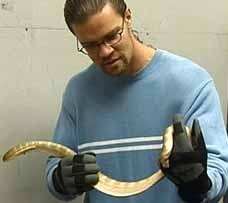 What should one do if bitten, say, by a pit-viper? Perhaps make use of a proprietary snakebite venom suction device? Maybe not such a good idea, according to recent research from Professor Sean P. Bush, MD, FACEP, (pictured right, holding a sea-snake) of the Department of Emergency Medicine, Loma Linda University School of Medicine, Medical Center and Children’s Hospital, Loma Linda, California.
What should one do if bitten, say, by a pit-viper? Perhaps make use of a proprietary snakebite venom suction device? Maybe not such a good idea, according to recent research from Professor Sean P. Bush, MD, FACEP, (pictured right, holding a sea-snake) of the Department of Emergency Medicine, Loma Linda University School of Medicine, Medical Center and Children’s Hospital, Loma Linda, California.
In a review of more than a dozen research papers which investigated the effectiveness of a selection of snakebite suction devices, the verdict was clear : Snakebite Suction Devices Don’t Remove Venom: They Just Suck (Annals of Emergency Medicine, Volume 43, Issue 2 , February 2004, pp. 187-188, ) The paper concludes :
“The best first aid for snakebite is a cell phone and a helicopter.”
BONUS: The full paper
BONUS: The Ig Nobel Prize-winning study “Failure of Electric Shock Treatment for Rattlesnake Envenomation.” [Annals of Emergency Medicine, vol. 20, no. 6, June 1991, pp. 659-61.]

May 6, 2014
Behold the Non-Squeezing Property Of Contact Balls
The field of mathematics often supplies papers that demand attention even from casual observers. Here’s a new one:
“Non-Squeezing Property Of Contact Balls,” Sheng-Fu Chiu, arXiv 1405.1178v1, May 6, 2014. The author is at Northwestern University.
Here’s detail from the study:
(Thanks to investigator Adam S. Levine for bringing this to our attention.)
BONUS (unrelated):
“IMPROVEMENT IN MACHINES FOR SQUEEZING PUDDLERS BALLS,” US Patent #190,385, granted to E. Suckow, 1877.
Here’s detail from that patent:
BONUS: Puddling

A hazard of snacking on beached whales
Further fodder for nutritionists who warn against indiscriminate snacking:
“Outbreak of Botulism Type E Associated with Eating a Beached Whale — Western Alaska, July 2002,” Morbidity and Mortality Weekly Report, vol. 52, No. 2, January 17, 2003.
Additional detail appeared in a later report:
“Botulism type E outbreak associated with eating a beached whale, Alaska,” Joseph B. McLaughlin, Jeremy Sobel, Tracey Lynn, Elizabeth Funk, and John P. Middaugh, Emerging Infectious Diseases, vol. 10, no. 9 (2004). The authors write:
“We report an outbreak of botulism that occurred in July 2002 in a group of 12 Alaskan Yu’pik Eskimos who ate blubber and skin from a beached beluga whale. Botulism death rates among Alaska Natives have declined in the last 20 years, yet incidence has increased….
On July 12, 2002, two residents of a Yup’ik village in western Alaska found a carcass of a beached beluga whale that appeared to have died sometime that spring. They collected the tail fluke for consumption, cut it into pieces, and put the pieces in sealable plastic bags. Portions were refrigerated and distributed to family and friends. From July 13 to July 15, a total of 14 persons ate some of the raw muktuk. On July 17, a physician from western Alaska reported three suspected cases of botulism from this village; all patients had eaten the muktuk. The Alaska Department of Health and Social Services began an immediate investigation….
Eating blubber from whale carcasses as described in this outbreak is in accordance with tradition; however, strong blubber in airtight sealable plastic bags, which can create an anaerobic environment, is a modern development. The use of airtight containers to store and ferment traditional foods is theorized to be at least partly responsible for the increase in incidence of foodborne botulism in Alaska from 1970 to 1997
(Thanks to investigator Kristine Danowski for bringing this to our attention.)
BONUS: “eBay ends auction for beached sperm whale in Newfoundland” [report in The Star, Tuesday, May 6, 2014, about a different beached whale in a different place]
BONUS (mostly unrelated): “Female North Atlantic right whales produce gunshot sounds“

Marc Abrahams's Blog
- Marc Abrahams's profile
- 14 followers


